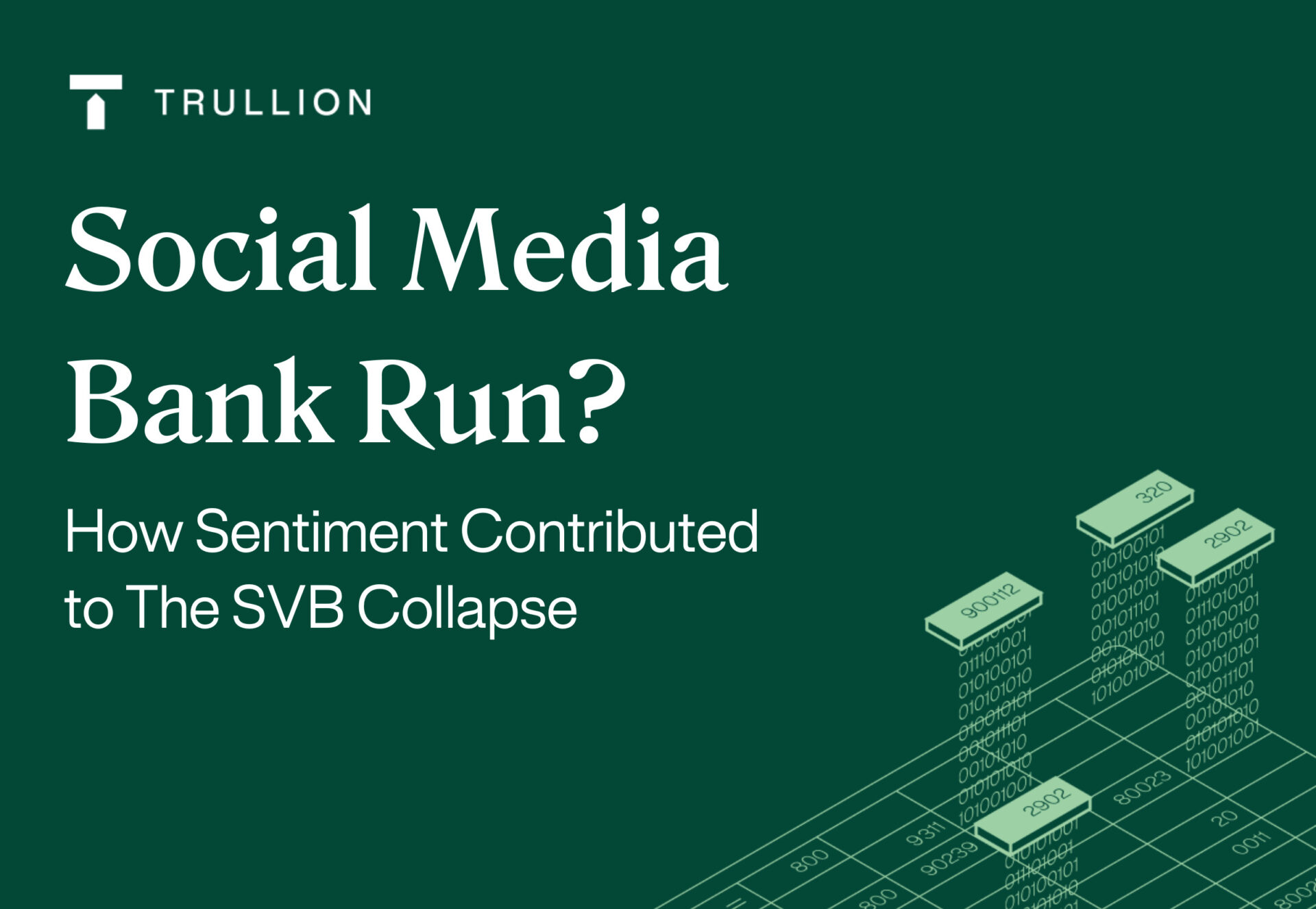Silicon Valley Bank, the well-known VC-backed startup lender, collapsed this past Friday in a stunning turn of events that is sending shockwaves throughout the financial ecosystem. Signature Bank was soon to follow as panic spread throughout the sector and a host of other banks find themselves under pressure.
While regulators and the industry work to unravel the precursors to the SVB crisis, many people are pointing to the power of social media, and in particular, to the power of sentiment – to have been the straw that broke the camel’s back.
While some order has subsequently been restored, there are some powerful lessons that need to be learned from this episode.
The Silicon Valley Bank collapse follows what was ultimately a classic run on the bank, to the tune of $42bn in one day, following the most unlikely confluence of several factors in the days and weeks prior.
Here’s how the SVB collapse happened
SVB’s troubles began when it started to experience liquidity problems, as customers drew on funds through a difficult ongoing macroeconomic environment. With capital less easy to come by for growing startups, the need to burn through savings reduced SVB’s cash holdings down from the giddy highs of recent years, where credit was cheap and customers’ reserves were high.
Acting to invest these reserves, SVB committed to long-term bonds, confident that liquidity would remain within bounds for the foreseeable future.
They were wrong.
As a series of interest rate hikes by the Federal Reserve made money more expensive to borrow, SVB customers drew down on savings, leaving SVB in a liquidity squeeze vis-a-vis regulatory requirements. With so much of that hay-day cash locked up in bonds, the bank was pushed to sell enough of them at a significant loss. This loss is just the tip of the iceberg – it’s estimated that banks have $620bn in unrealized losses due to the effects of recent interest rate increases. The market reacted to this with concern. As caution led to a fall in confidence, SVB’s share price began to tumble, pulling the rug from its plan to improve cash on hand through a stock sale. A rating agency downgrade set fire to the already frenzied sentiment.
The problems at SVB quickly became a topic of conversation on social media, and the negative sentiment soon turned into fuel for a full-blown bank run. Customers withdrew their money, despite reassurance from SVB leaders that the only scenario of concern for liquidity would be if customers followed one another in a stampede to withdraw their holdings.
But the writing was on the wall. Perhaps more accurately, it was all over The Feed.
The echo of concern rattled through the Twitter-sphere in no time, with some VCs encouraging portfolio companies to withdraw their savings as soon as possible from SVB. The final straw came when the bank was unable to meet the tsunami of calls for withdrawals, and Federal regulators stepped in to freeze trading and place SVB into FDIC receivership.
The power of social media to trigger, or at the very least contribute to a bank run is a worrying development. It could have serious implications for the stability of the financial system and yet has no formal relationship to the checks and balances that are in fact designed to regulate confidence and clarity around market movements. Though sentiment-driven trends are as institutional as bull and bear markets, there is something outsized about the speed, and magnitude of social media’s role in the downfall of an institutional bank.
A closer look – how did social media play a role?
Social media is often seen as an echo chamber, but in the case of SVB, it also served as a magnifying glass, amplifying a handful of early concerns to a near-audible crescendo of panic. Stoking up the latent fear in customers, who, feeling the crunch of the broader macroeconomic downturn, were looking to cut costs. The fear soup served up via The Feed was enough to snowball into a fully-fledged bank run, with social media providing a unique platform to galvanize a mass response that could not be contained without the intervention of regulators.
Platforms such as Twitter, in particular, provided a useful way to spread information and amplify an already anxious public opinion. It was indeed the perfect forum for news and rumors to drive a never-ending chain of customer flight. In this situation, the financial community can learn from the events of the past weeks, in particular the parts of the story which took place on social media – as this kind of customer flight can be damaging, not just to the individual bank, but to the entire financial sector.
What could have been done differently?
While there can be no crystal ball that might have enabled SVB to see the situation for what it was and take the correct steps to protect their capital and the confidence of their customers in a more timely, measured way, it is clear that – in hindsight – SVB could have been more open and transparent in its communications.
Withdrawals, trends, and rumors of impending financial meltdown should have been flagged more prominently as customer-centric practice, not as strategic play concerning the efficiency of the bank’s capital reserves. Questions surrounding investment choices, liquidity ratios, and adherence to regulations will follow. Consider for example the role of CECL (ASC 362), IFRS 9, and IFRS 17, all geared to ensure that anticipated future losses are reported more transparently. The latter standard came into effect as recently as January 1, 2023, and suggests an ongoing improvement to the regulatory framework that has indeed given strength to the financial sector on the back of lessons learned in the 2008 crisis.
Yet somehow, SVB’s previous quarterly disclosures weren’t worthy of the internet frenzy that took hold of, and precipitated the decline of the USA’s 16th largest bank this week, in under 48 hours. It would appear, in fact, that little new information regarding SVB’s financial position has come to light this week that was not already in the public domain many weeks ago.
Could a social tsunami have been avoided?
The power of social media to be leveraged for stability, market education, and fair assessment of risk, cannot be ignored. Employing a more proactive social media management strategy could have potentially countered the negative sentiment, or enabled SVB to get ahead of the wave, pushing back to regain control before it was too late. Keeping a pulse on industry opinion, and monitoring, not just the accounts of the bank, but of their customers and key stakeholders could have provided insight into market trends that may have enabled a much-needed preemptive move. It could have been a move to boost confidence or manage expectations, or simply put out fires before they had a chance to sway the market.
Information futures
Though a series of unfortunate missteps led to the SVB failure, it is clear that the banking system as a whole (not to mention other industries) must take steps to harness the power of social media, engendering trust with partners, customers, and community and to avoid rallies of sentiment to take shape in the absence of knowledge.
Banks could enable the public to ‘put their money where their mouth is,’ so to speak – by actively engaging in the conversation on social channels and rewarding customers for their loyalty and trust in the system, thereby leveraging the goodwill of social media for the benefit of their customers, and the financial sector at large.
On the regulatory side, dedicated watchdogs could likewise monitor public sentiment, in order to provide a timely read on any movements that may warrant closer investigation, or at least require further scrutiny, in order to help ensure that news remains in the domain of the facts and not of panic. In a sense, social sentiment has grown to become a legitimate concern of regulators and government alike. Both will be called on to provide backstop support in times of crisis, and so their role ahead of difficult times seems only prudent.
The events of this past week have not only highlighted the power that social media has within the financial ecosystem, but also the importance of financial institutions taking a more proactive approach to their communication strategies, as well as the need for policymakers and regulators to develop a more nuanced understanding of digital trends, in order to pre-emptively contain any widening cycle of fear and panic.
At the source of all uncertainty, lies the absence of visibility and transparency as to what the future holds. Technology will continue to meet the need in this space, and we will all reap the benefits of data clarity and market confidence as a result.









